#kingdom come... deliverance.... 2... I think
Explore tagged Tumblr posts
Text

war's a nasty business
#kingdom come deliverance 2#kcd2#istvan toth#kcd erik#you ever just think about them and go AUGH and then continue as you were#looking forward to meeting them in the first game#i was just sent to hunt with hans so itll probably take a hot second but im patient#(she lied)
92 notes
·
View notes
Text
An Unreasonable Amount of Information About the Mysterious Racek Kobyla.
Oops, I've tripped and fallen into a total research pit about Dadzig. In my defence, my entire academic career was built on researching mega obscure medieval history and there's nothing like the thrill of chasing down a niche pdf in a language you can't read for a vital bit of intel that only gives you more questions. 😎
(Disclaimers that while I have an MA in medieval history this isn't a time period or place I specialise in, I also don't speak Czech and have relied heavily on language translators, as well as open source texts. Adding to that, information is so scarce we can't really be sure of anything. Such is the joy of studying obscure medieval history!)
In this infodump, I'm gonna ask (and not necessarily answer!) the deeply obscure and conceivably uninteresting questions of...
Which Dvorce was Racek Kobyla, of?
Did he have kids?
(Massive side tangent about the castle he builds, Veselé)
and, Who's this Niclas of Dvoretz guy? (And, if anyone knows, please tell me!)
Hang on, which Dvorce?
We don’t know much about (essentially anything) about Racek’s early life, and when I started to look into him, I got a bit tripped up over the fact that there’s quite a few places called Dvorce in the Czech Republic, a lot of which are small villages with little to no available information. These are my three top contenders of places that have an appropriate medieval history, and links to what we know about this guy. I've ranked them from least to most convincing. (In my opinion)
Jičín Dvorce: There's a Dvorce near Jičín which is so small as to not even have a Wikipedia page. The interesting thing about this one is that it's right next door to a village called Úlibice, first recorded in 1355. Racek was married to a woman called Anna of Úlibice, and since I haven't found another settlement by this name, I'm assuming she was from this Úlibice. Over all not particularly convincing, but an interesting coincidence!
Prague Dvorce; Maybe a bit of a wild card, but there's a place in southern Prague on the Vltava river labelled 'Dvorce' on Google Maps. It's a bit outside old-town prague, and is about a thirty-minute walk from Vyšehrad, which we knew he was Burgrave of from 1410-1415. I can't figure out much about the history of the area itself, it mostly flags on Google Maps because there are several tram and ferry stops (as well as a spa and beer garden) with the name Dvorce. This proximity to Prague could explain how he comes into the orbit of Wenceslaus, but I think this a bit tenuous. Also, there's a boat hotel nearby called Botel (Boat) Racek. So. Theres's that.
Bruntal District Dvorce in the west, which first pops up in written records in 1339, and is referred to as a market town (like Rattay) in 1363. This is in the Moravian region, which could explain Racek's links to Prokop of Moravia. It seems this town was founded by a noble family called the Šternberks, who owned it till 1406. Radzig is a minor noble, so it's possible he was from this Dvorce, and was part of a family that, while part of the knightly class, did not own significant land or fortifications. The KCD Codex refers to him as a ‘yeoman’ (aka, a non-landed gentry,) which would fit in this interpretation. I think this one is probably the most likely, and the one he most people commonly link him to.
What about his family?
I can't find out much about the Kobyla family outside of him. Wikipedia (slightly frustratingly, my main source here,) mentions that after his death, his widow inherited the castle he built, Veselé and it's surrounding villages, while his children were left under the guardianship of two knights, one called Mikuláš Šraňek, the other Mikuláš of Reblic. The need for guardianship would imply that these children were not adults, and/or were female.
The source Wikipedia is citing here, Tomáš Šimek et al's 'Castles and fortresses in Bohemia, Moravia and Silesia (Book 6 - East Bohemia)' (Which is available in its entirety on Academia.edu) doesn't mention children. Disclaimer that I'm using translator apps here, but, best as I can tell, the section this claim is referring to is about property rather than children;
'The castle was then held by the widow Anna of Úlibice together with Mikuláš Šraňek and Mikuláš of Úlibice. In 1426, she transferred her right to the local goods to Vilém Kostka of Postupice, who also acquired the other shares — he was already writing on Hradek in 1423.' (Šimek et al, 'Castles and fortresses in Bohemia', p.202.)
A different source I found does refer to children, and mentions,
'the knights Mikuláš Šraňek and Mikuláš of Reblice, as guardians of Racek's minor children.' (Historie a současnost Komorního Hrádku, p.8)
This same source also tells us that Anna of Úlibice had remarried, and had a son named Václav (Czech spelling of Wenceslaus) Vlk (which means wolf?) (Wolfeslaus?) , though it is unclear if this was a child of Racek. It seems very likely for Racek to name a child after the king he serves, but equally possible that her new husband, Kuneš of Hořejší Ves, wanting to maintain favour with the king, would give their child that name.
But we know that Vaclav doesn't inherit Racek's estate;
'despite having a son, Václav Vlk, and a second husband, Kuneš of Hořejší Ves, in 1422 [Anna] ceded her estates... to the Hussite hetman Vilém Kostka'.
What happened then to Anna, Vaclcav or any other potential children, I haven't been able to track down at all. It's entirely possible these children simply don't survive, or are not suitable to inherit Kobyla's estate.
Time for a (not at all) brief Veselé diversion, because it's really interesting.
Veselé was built in a village called Komorní Hrádek (which is what the castle is now referred to) on the Sassau River, which is just a little further west than the KCD1 map shows. As the crow flies, its 5km from Skalitz, and 10km to Rattay. (Which I think would be about a two-hour horse ride? Just interesting information from a fic perspective.)
Before Veselé, there was a castle on this site called Čejchanov that was built sometime before 1356. At the end of the 14th century, during the political instability of Wenceclas' capture, this castle was seized by knights formerly in Wenceclas' service, Mikeš Zoul of Ostředek, and his son Jan. They used this castle as a base of operations as they conducted robberies throughout the region, and were joined by other robber barons, including Hynek the Dry Devil!
After a series of castle seizures and royal pardons, the Zoul's eventually earned the ire of Wenceclas enough to be declared pests and be targeted by royal forces. Archbishop Zbyněk Zajíc of Hazmburk, (The illiterate archbishop of Prague nicknamed 'Alphabet', who is mentioned during Godwin’s section of the Papal legate quest) led a force to seize the castle, and capture the Zouls and fifty of their men, who were then executed in Prague in 1403 with their property distributed to the King's supporters. Jan’s body was left hanging on a hook for 7 years. Mikeš, interestingly, was escorted to the gallows and prompted to repent by Jan Hus before his execution!
(Sidenote one: Racek would come into conflict with Archbishop Zbyněk later in life, after the archbishop seized and burned the books of John Wycliffe that had been deemed heretical, and further refused the orders of the king to compensate the owners of the burnt books, Racek was tasked with confiscating the property of the archbishop and his subordinates.)
(Sidenote two: the Zoul family feature in game in the form of Hagen Zoul, from the Band of Bastards DLC. This is their crest, and the decorated cuirass he wears. Hagen is inspired by an uncle who is mentioned to have joined the raids, and if Henry lets Hagen go, he agrees to stop pillaging, but can make no promises for the rest of his family. The history is slightly different than in the game, but it’s an interesting inclusion!)

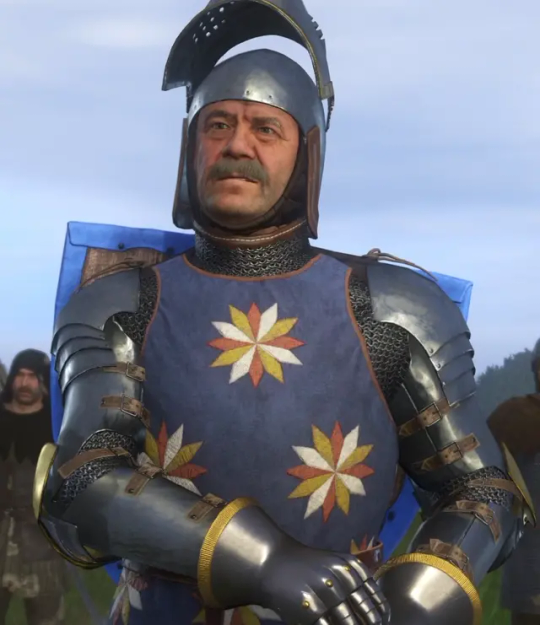
In 1412, Racek was given permission to build a castle called Veselé at this site from King Wenceslaus. The letter of permission reads (translated as);
"We, Wenceslas, by the grace of God, King of the Romans forever exalted and King of Bohemia, announce to all with this letter that for the devoted, careful, useful and tireless services that the famous Racek of Dvorec, burgrave of our castle of Vyšehrad and our dear and faithful servant of our Grace has enthusiastically rendered and will in the future demonstrate all the more enthusiastically, not by mistake or foolishly, but after careful consideration, we have accepted him and his heirs into grace and hereby, by the power of the King of Bohemia and with our firm conscience, we continue to accept them into grace and by our special grace we consent that the castle of Veselé (Komorní Hrádek), which stands above the river generally called the Sázava, be rebuilt, erected and built, fenced and fortified in stone, so that they can better put it in order and they and all who belong to them can have it in possession and to possess in peace, while all burdens will be taken away from them. We therefore definitely and irrevocably order all noble lords, knights, yeomen, administrators, burgraves, hetmans, burgomasters, sworn aldermen and councils of municipalities, cities, estates and villages, as well as other loyal subjects of ours and the Kingdom of Bohemia, of whatever status or position, present and future, not to hinder the aforementioned Racek and his heirs in the construction, erection and building, fencing and fortification of the aforementioned castle of Veselá and everything that belongs to it, but on the contrary to allow them to reside in its surroundings in peace and quiet, if they wish to consistently avoid our most bitter indignation."
It seems likely that Racek was castle building before getting official permission, as in 1411, he was styling himself as 'of Veselé' as well as 'of Dvorce.' (Šimek et al)
It was one of few noble castles built during this time in the region, likely because the prior fortification had proved easy to capture, as it was positioned very poorly to defend against firearms. Subsequent generations have built on top of this gothic castle Racek built, and so it's exact layout is hard to tell. However we do have this description;
"From the previous – so far only superficial – survey of the castle, it can be concluded that the original Gothic castle contained three one-storey wings, occupying the position of the southern, western and northern wings of the older part of the present-day castle. It is also impossible to have a more definite idea of the external fortifications of the castle without archaeological survey. There was undoubtedly a massive fortification wall with a moat on the eastern, southern and western sides. At the southern corner of the wall, at the site of the southeastern corner of the so-called courtyard (in front of the current canteen), there stood a cylindrical tower, which protected the castle mainly from the side where the terrain was not very steep and therefore more easily accessible. On the northern side of the castle, above the steep slope, the main defensive task probably fell to the polygonal bastion, the remains of which can be considered the masonry of today's polygonal enclosure of the castle chapel. Inside the courtyard there was a well with a stone surround."

This is what Komorní Hrádek chateau looks like today, most of this being additions from the 17th century.
Now, who's this Niclas chap?
Wikipedia's first source for Radzig Kobyla's establishing details is a doctoral thesis in German about the establishment and funding of a hospice for pilgrims in the alpine village of St Anton am Alberg. (A project conducted by a chap called 'Henry the Foundling' who was, fittingly, found as an infant in the 1370s.)
The thesis focuses on a book used to keep track of donors, recording their names, offerings, and coats-of-arms.
And, it includes reference to a Niclas of Dvorce/Dvojic/Dwoygicz, who, starting in 1403, donated four guilders every year.
His genealogy information is included as; 'The seat of the Kobyla and Dvojic/Dvorce family is Komorni Hradek Castle [Vesele] in Bohemia. Racek of Kobyla and Dvojic/Dvorce was burgrave around 1400. He was in the court of King Wenceslas IV of Bohemia, burgrave of Vysehrad from 1410 to 1415, and died in 1416.'
The coat of arms is described as 'The helmet is connected with a chain link with a wreath of coiled, infinitely intertwined, flaming bundles of ears at the cut surface'

This is the Kobyla coat of arms. What do we think, does it sound similar?
So who's this guy then?
I briefly entertained the thought that Niclas might be this son of Anna that is mentioned, Václav, on the grounds that... the names sound slightly similar, but then immediately convinced myself otherwise. Václav is the Czech version of Wenceslaus. (Or indeed, Wenceslaus is the Latinised version of Václav.) The dates are also way off - if Racek has minor children when he dies in 1416, his son isn’t donating to Austrian alms houses in 1403. My best guess is, maybe his brother? Uncle Niclas!
But the conclusion is, I don't know! Does anyone else know?
On that note, if anyone with more expertise on Czech History and this time period wants to chime in with any intel/corrections, please do!
Sources;
Bohemia, Digital library. “Tomáš Šimek a Kol.: Hrady, Zámky a Tvrze v Čechách, Na Moravě a Ve Slezsku (Kniha 6 - Východní Čechy) / Castles and Fortresses in Bohemia, Moravia and Silesia (Book 6 - East Bohemia),” n.d.
https://web.archive.org/web/20240713044542/https://mocr.army.cz/assets/multimedia-a-knihovna/publikace/utvary-zarizeni/08-historie-a-soucasnost-komorniho-hradku---ce.pdf
#kcd#anyway this is. a lot. I acknowledge I'm kind of... skimming over the basic details of his life? Like oh boy we could talk about his death#and explain the whole robber baron thing / his time doing guerilla warfare with Zizka et alagainst Sigismund loyalists the Rosenburg family#that I think are set up as villains and the 3rd game could very likely be about?#But anyway I've been researching Vesele for a while largely bc I think it's interesting for fic reasons.#Henry could be involved in the building/running of this estate that is very close to Rattay#Or else Dadzig is just close to Rattay#Wenceclaus is also clearly of a mind to do Radzig favours but Radzig is maybe also not waiting around for his permission todo what he wants#And does Radzig get re-married and have small children and how does henry feel about that and how does he feel about his young half-sibs#especially if one is a boy and thus gets in the way of the main reasons/ legal justifications for Henry to be legitimised -#Radzig not having an heir#idk idk it's all just. inchresting to me.#kingdom come deliverance#Radzig Kobyla#Dadzig#Long post#kcd2#kingdom come deliverance 2
26 notes
·
View notes
Text
My dash really came together beautifully to make me care very much about the survival and knightly romance of that snobby-nosed snobbier-named Hans Capon guy and his little boyfriend while also knowing NOTHING about the game and / or the stakes. Well done you madlads you did your part 🫡
#kingdom come... deliverance.... 2... I think#to be deleted#need to buy the game so I can discover how the player character is called at the very least#hopefully something less ridiculous than hans capon
13 notes
·
View notes
Text

Happy pride and happy Hansry week!
I’d actually love to do a daily thing but I have a whole semester to make up for in 3 weeks so no more of da boys probably until i’m done ._.
Hans is taller supremacy
#im on so much caffine i think my body is gaining sentience separate from my brain#also the reason i didn’t use the prompt is because i just don’t have the time to follow them so just random art it is#hansry#kcd 2#kcd#kingdom come deliverance 2#kingdom come deliverance#my art#fanart
1K notes
·
View notes
Text

#I think it should be their wedding vows#hansry#hans capon#hans x henry#kingdome come deliverance 2#kcd2#kingdome come deliverance#henry of skalitz#my art#kcd henry#kcd hans#kcd
2K notes
·
View notes
Text
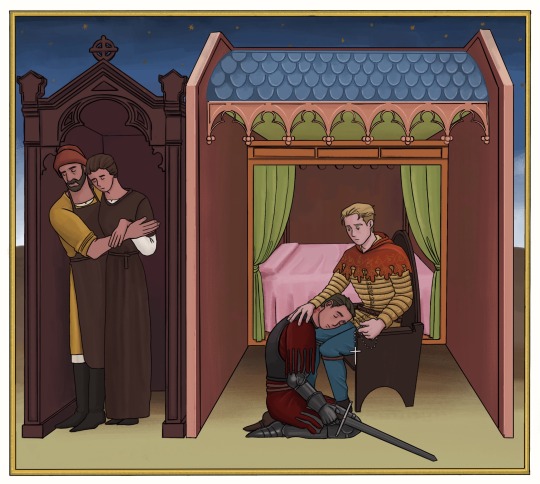
The weight of sins
#this piece took so long but honestly it’s one of my fav so im glad to finish it#I think about branded Henry all the time#kingdom come deliverance#henry of skalitz#hans capon#hansry#kingdome come deliverance 2#kcd martin#Henry’s mom#please WH can we get a name??#my art
551 notes
·
View notes
Text
if you ever wonder if i’m thinking about you, the answer is no. i’m thinking about gay knights kissing
#exclusively#apple babble 🍎#hansry#kcd#kcd2#kingdom come deliverance#kingdom come deliverance 2#henry of skalitz#hans capon#they have consumed my mind body and soul#no but the way i actually cannot think about anything else is crazy#they’re rotting my brain (affectionate)#😭😭😭😭
643 notes
·
View notes
Text



#and probably...presumably...other...activities...maybe?#but like okay henry keep talking about that tongue of his#i'm suuure you're not thinking of other things#no other mental images popping up in there#no just hans with his way with words am i right?#you're definitely not thinking of all the other things that tongue could probably do#hansry#hans x henry#hans capon#henry of skalitz#kcd2#kingdom come deliverance#kingdom come deliverance 2#my gifs#hansrygifs
689 notes
·
View notes
Text






thinking about this exchange again
#kingdom come deliverance#kingdom come deliverance 2#kcd#kcd2#henry of skalitz#hansry#?#coincidence I think not
351 notes
·
View notes
Text




hans & henry: covered head to toe in human blood also hans & henry, looking at zizka's wounded eye: 🤢🤢🤢🤮🤮🤮
#kingdom come deliverance#kcd 2#hansry#kcd2 spoilers#hans capon#henry of skalitz#video games#video game edit#my gifs#had to gif this because their reactions are so funny#you'd think at this point these boys wouldnt be squeamish anymore sjdfhks#they have literally killed people#but i guess a puss-filled eye is different than a dead body so they get a pass lmao#is there even a kcd fandom on tumblr#am i gonna get like -10 notes on this post sjdfhk#also yes i am a longer hair and beard henry truther <3 thank god for the barber patch
505 notes
·
View notes
Text
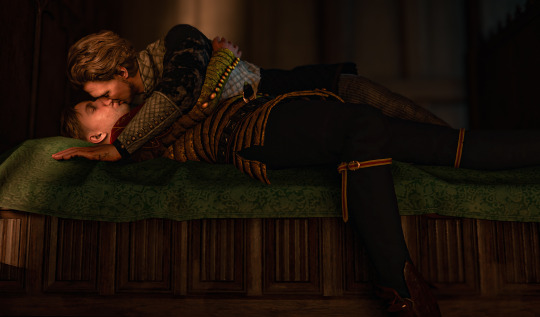
.
#i cant think of a caption#I LOVE THEM#hansry#henry x hans#kcd2#kingdom come deliverance 2#kingdom come deliverance#rpg
450 notes
·
View notes
Text
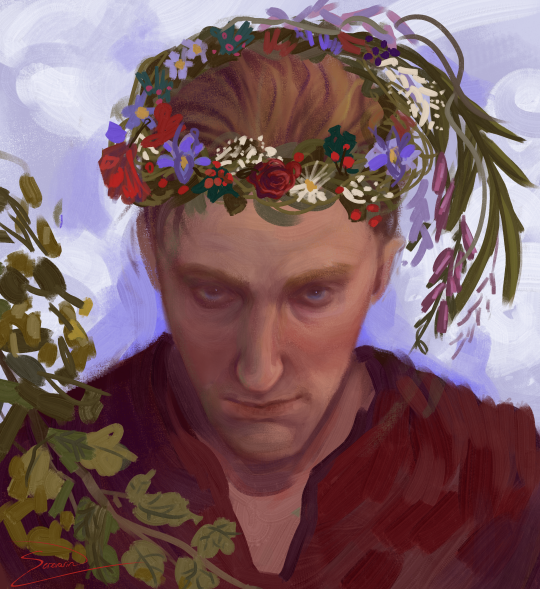
jan ptáček. hans capon. little birdie. flowers in his wreath: begonia as "caution", blueberry as "trust", holly as "protection", lavender as "I will never forget you". ... *whisper* and also as "lavender marriage".


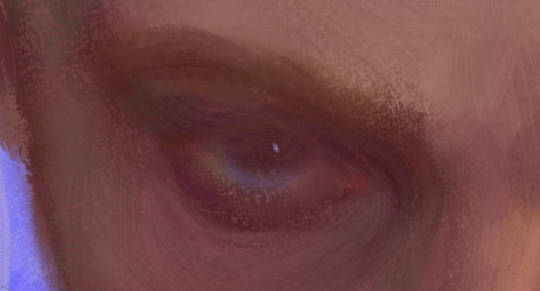

#hansry#kcd#kcd2#kcd fanart#kingdom come deliverance#kingdom come deliverance 2#jan ptáček#jindřich ze skalice#hans capon#henry of skalitz#my art#they deserve happiness but i love angst at the same time!!#so i think they will both engage with some women for the sake of LAVENDER marriage#likeee we can say possibly Henry x Theresa and Hans x Jitka#but the marriage is LAVENDER (=a marriage for convenience) and they still secretly love each other. hear me out.#soooo hans names his son henry. yep.#but “i'll never forget you” and they never do.#they are almost unseparable#a knight and a noble#not often present in their families#“haha they are such good friends :) :) :)” someone would always say#but nobody knows that they spend so much time together (instead of raising their kids or being at home and helping with the homestead etc)#because they. love. each. other. so. much.#and it's concealed subtly. their love is a work of art#so hidden and ethereal#i want to believe in that. i love angst but i can't think of a bad ending for them.
914 notes
·
View notes
Text
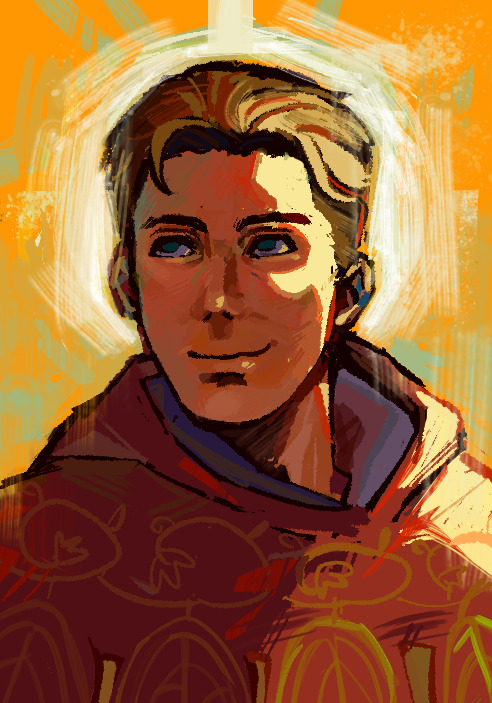

Disco deliverance
#second attempt in studying the artstyle lmao#i think i improved#theres alot of details thats supposed to represent some stuff related to the events of the game and their relationship to each other#its on my twitter im not gonna write allat#kcd#kingdom come deliverance#kcd2#kingdom come deliverance 2#henry of skalitz#hans capon#hansry
363 notes
·
View notes
Text








"I've been thinking a lot about what you told me at Maleshov." | Taking French Leave, Kingdom Come: Deliverance II (2025)
#every time i think i'm retired from fandom and then wake up one morning going 'fuck i no longer have my giffing tools my photoshop is gone'#that final henry gif is gratuitous but i like how genuinely he likes hans's sense of humor ok#kingdom come deliverance spoilers#kingdom come: deliverance 2 spoilers#kcd2 spoilers#kcd2#kingdom come deliverance#kingdom come deliverance ii spoilers#kingdom come deliverance ii#henry of skalitz#hans capon
715 notes
·
View notes
Text




#kingdom come deliverance#kingdom come: deliverance#kingdom come deliverance 2#kingdom come: deliverance 2#henry of skalitz#hans capon#hansry#kcdedit#*my edit#kcd2 spoilers#erik this may surprise you but henry sure is out here understanding#me? making gifs of a sequel i havent played? its more likely than youd think
460 notes
·
View notes
Text



“I came to save your noble arse!”
#i think my bloody henry really adds something#shows how much he’s gone thru to get his lord back#kingdom come deliverance 2#kingdom come deliverance 2 spoilers#kcd henry#henry of skalitz#hans capon#kcd hans#kingdom come deliverance#kcd#kcd 2#kcd 2 spoilers#hansry#henry x hans#henhans
359 notes
·
View notes